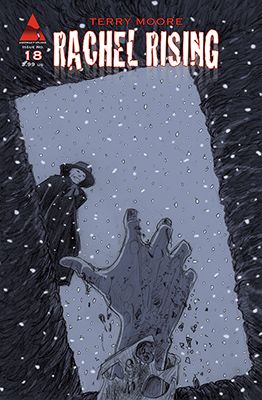"Rachel Rising" #18 by Terry Moore continues the slow build of action around Lilith, the town of Manson, and Zoe and the Malus-possessed priest, and then veers towards an unexpected, shocking cliffhanger in its last two pages.
More than half of "Rachel Rising" #18 is the conclusion and aftermath of the ritual for Lilith's phoenix-like rebirth. Moore portrays Lilith at her most vulnerable and in a scene that leads to a renewed state of vengefulness. She comes across as more pitiable than ever before, and her nakedness reinforces the symbolism of birth and her lack of power. Moore keeps the snowy setting as white as possible, making the scene feel floaty and separated from the normal passage of time. Each gesture in a near-silent progression of panels feels heavy with emotion and significance. This slowing of time also emphasizes the eerie atmosphere and growing desperation of Lilith.
The following scene at the Manson police station creates more suspense about what fresh hell awaits the citizens of Manson from acts of sabotage. Moore's technique of revealing these details through the frame of a police interrogation is workman-like, but it gets the job done for getting across certain plot points. Also, Moore's blow-by-blow facial expressions and body language for poor Mr. Ruiz are fantastic. Mr. Ruiz is a stand-in for all the innocents in Manson, and his bewilderment, distress and cluelessness add a pinch of black comedy the otherwise grim tone of "Rachel Rising" #18.
The darkest scene is between Zoe and the priest. Separately, their casual attitudes towards violence and their subtle menace are disturbing. Her seeming youth and his seeming clerical status heighten these effects, and together, they are terrifying. Their talk in "Rachel Rising" #18 makes the reader a witness to the further corruption of a soul. It's a little stomach-turning, yet there is no gore on-panel, just a thick knot of words to further tie Zoe to Malus' intent.
All these scenes push the plot forward a little, but none of them are a game-changer. Most of "Rachel Rising" #18 feels like transition material. The meatiest bit of plot is at the end.
It would be difficult to overstate the strength of Moore's cliffhanger for "Rachel Rising" #18. His panel layout and composition draw out suspense slowly across two pages. The final three pages are ominously silent, and the reader follows Earl as he takes in the facts and has a heartbreaking response. Moore consistently handles morality with subtlety, and the tragedy within this scene is yet another example. The twist seems to come out of nowhere, but Moore has laid down clues previously through characterization.
"Rachel Rising" #18 is another excellent chapter in Moore's horror story about good and evil, innocence and guilt, life and death. Since his early work on "Strangers in Paradise," Moore has always handled comedy, body language and facial expressions with enviable ease, but his plotting and characterization were weakened by melodrama and far-fetched plot extensions. In "Rachel Rising" #18, Moore has maintained and refined his emotional and comedic powers, and compared to his earlier work, he has also become far subtler and deliberate in his plotting and more profound in his thematic depth and breadth.

